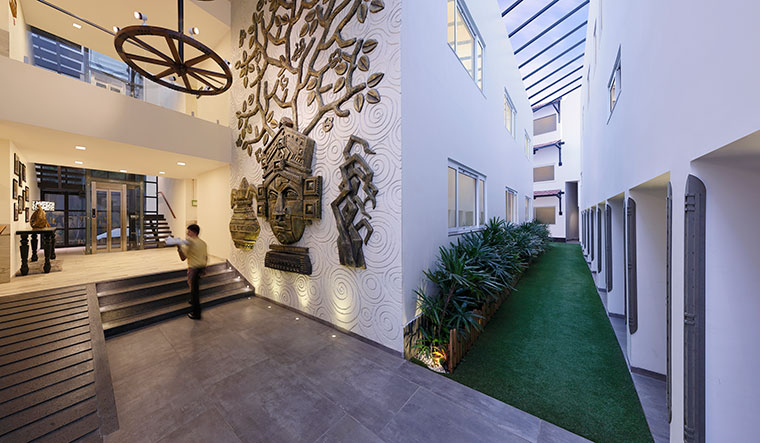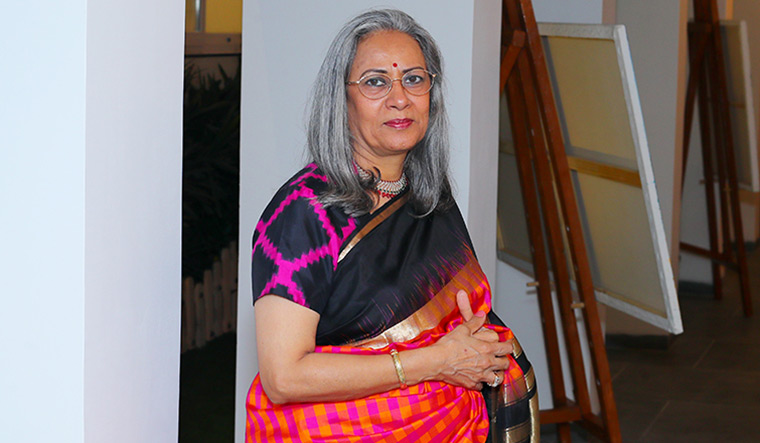How would you like to be an asura for the night? At the Ravana room at Mumbai’s Le Sutra Art Hotel, there is a life-size mace you could strike a pose with, and a chair with horns at the back—perfect props for a very Instagram-able image. That is not all. One wall of the room is adorned with a painting depicting the demon king in all his facets, from the pundit to the asura. “Then we have, instead of his ten heads, an interpretation of the ten heads through twenty gleaming eyes (on the wall),” said Radha Bajaj, whose family owns the hotel.
No wonder the room commands the highest tariff among all the art concept rooms at Le Sutra. Not the Krishna room, nor the Dushyant-Shakuntala one; not even the Sattvic rooms themed after the Buddha. It is the Ravana room that is most sought after, be it by corporate types travelling on work or the increasing tribe of the art-curious in India.
Hotels themed on arts, crafts and design seem to be the next logical step in the boutique hotel boom in India. As more people travel these days, many believe out-of-the-box innovations like these help a hotel stand out amongst the clutter.
“Art is an all-consuming experience,” said Ashish Vohra, founder and CEO of Justa group of hotels, which uses art and design elements in all its properties across India. At Justa’s Design Hotel in Chennai’s Phoenix Marketcity, rooms are designed on the styles of four distinct south Indian art or architectural styles. The rooms are called Ati (Kolam rice art), Maya (Tanjore), Rooh (Madurai Meenakshi temple-inspired) and Nunya (south Indian contemporary).“There is no xeroxing or cookie-cutter format in any of our hotels. Art becomes the fulcrum of how we differentiate our product,” said Vohra.
Take for instance the Andhra Arts & Crafts Hotel in Visakhapatnam, launched in February. On the face of it, it is a boutique, sea-facing luxury hotel and an extension to the established Palm Beach Hotel nearby. But it has one unique proposition—it was conceptualised and launched as the ‘world’s first arts and handicrafts hotel’.
“When the coastal zone clearances for the building construction came through, the management said, 'Why don’t we take it to the next level?'” said Ameet Mirpuri, the project's chief interior designer. The idea was to use art forms and craftsmen from Andhra to give guests a curated experience of the state. “Compared with a 200-room hotel where each room looks the same, a 24-room hotel where each room looks different was much more taxing,” he said.
It is a sensory delight. The rooms are divided into four categories, each themed on a specific art form, namely Etikoppaka—a lacquer-finish, wooden toy-making craft from a village of the same name outside Vizag—Kalamkari handpaint work, Srikakulam’s brassware and Andhra's famed shadow puppet theatre tradition called Tholu Bommalata. Craft and art works permeate every corner of the hotel.
Interestingly, the artists who worked on the project—from award-winning local crafts consultant Karthik Krupanand to students from the Andhra University’s art department—did not directly re-create the traditional forms, but gave it a modern interpretation. As Radha Bajaj puts it, any art hotel concept has to be relatable to even the tech-savvy 25-year-old.
Of course, an art hotel is not just a hotel with paintings or sculptures strewn across like most iconic hotels in India. “An art hotel has to have art as the medium of story telling,” explains Bajaj. “Otherwise, you can buy art from the market and put it there and call it an art hotel. That is [just] a hotel with art.”
This new breed of art and design hotels takes it across the whole gamut. At Le Sutra Mumbai, every guest receives a work of art as a gift on checking out, like a yog dhand or a rudraksh. Similarly, those at Andhra Art & Crafts Hotel receive an original work of art based on the theme of their rooms when leaving.
Lake Nahargarh Palace, a luxury art-themed resort in Rajasthan, hosts artists both domestic and international on a regular basis; trips to nearby Bandi village, known for its art and architecture, is encouraged. Justa’s property in Sajjangarh, Rajasthan, was recently described as ‘the most art-heavy hotel in the world’. “[The art concept] has to extend into every element, right down to the food,” said Bajaj.
It can be good economics, too. “The time it takes to make an art hotel is double that of a regular hotel, and my cost is 10 per cent more,” points out Bajaj. “But I recover it by charging a higher price.” Adds Sandeep Reddy, general manager at Andhra Arts & Crafts Hotel: “By adding the art element, you get the extra push to your value, [and to the] room rates.” It helps if the hotel has a space constraint—it is no coincidence that many of these art and design hotels are smaller properties.
“Art hotels make you connect with your soul,” said Vohra. “People love the difference of the experience. [They] love the storytelling,” adds Bajaj. Extending the concept, the Bajajs are presently working on a premium housing project themed on art in Mumbai. An art hotel in Dehradun is also said to be on the anvil.
How the art hotel trend began
Ian Schrager is the powerhouse American entrepreneur credited with the whole ‘hotel as a lifestyle destination’ boom. Schrager came to fame, and notoriety, in the 1970s after launching the definitive landmark nightclub that symbolised the excesses of the disco era—Studio 54. After reports of drug-and-sex-fuelled celebrity parties in its VIP section, police raids, run-ins with the mafia and a bout in jail for tax evasion, Schrager got into the hotel business in the 1980s, kicking off the boutique hotel concept with New York’s Morgan Hotel.
With quick additions like Paramount and Hudson hotels in New York, Mondrian in Hollywood and St. Martin’s Lane in London, most of them designed by Philippe Starck, Schrager changed the face of the hotel industry. He turned hotels into THE place to be seen, where people can easily be spotted in a stylish and sophisticated setting like the hotel’s lobby or the bar, even if they cannot possibly afford to stay in its suites. The phrase "affordable chic" entered common parlance.
In the 2000s, declaring that people were getting bored with the very same boutique hotels that he kick-started, Schrager went in for his next differentiation—he bought the Grammercy Park Hotel, once a New York institution that seemed to be past its prime, and turned it into what is widely considered as the world’s first art hotel. This sparked off a new trend, with Europe especially quickly taking to the idea.
After selling off the Morgans group as well as Grammercy Park since then, Schrager now has a new hotel brand, Public. The first Public hotel, in New York, launched in 2017, claims to have the fastest free wi-fi in the city, the USP of the hotel apparently being quality and service at very affordable rates. He reportedly also has a tie-up with Marriott, the world’s biggest hotel chain, for the sub-brand ‘Edition’. One of the Edition hotels is slated to come up in Gurgaon.





